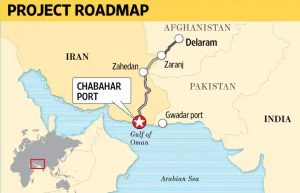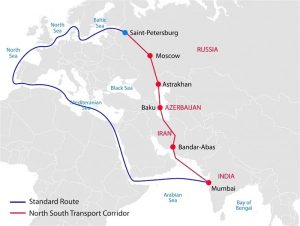Chabahar port
About Chabahar port
- Chabahar port, which is being jointly developed by India, Iran and Afghanistan, is located in south Iran on the Gulf of Oman.
- Pakistan’s Gwadar port is about 70 kilometers to the west along the coast.
- Afghanistan is connected to the chabahar port through its land border with Iran, and India via the sea.
- Thus, the port is readily accessible for all three countries and acts to facilitate trade among them.
- In 2003, India, Afghanistan and Iran, under the North-South Transport Corridor framework, signed the Chabahar port agreement, allowing all three countries to utilize the Chabahar port as a trade hub.
- The first phase of Chabahar port was inaugurated in December 2017.
Strategic significance of the Chabahar port
- It is an important pillar of Indian foreign policy aimed at finding shorter routes for its exports and imports, countering China’s influence in the Indian Ocean region, and circumventing Pakistan’s Gwadar port.
- Chabahar is the only port outside of Pakistan that connects Afghanistan to the sea.
- The port will also connect India to Central Asian countries that are also major energy producers in the region.
Chabahar-Zahedan Railway project
- It was expected that in addition to the investment in Chabahar Port, India could also play a more crucial role in funding and constructing a strategic transit route from Chabahar to Zahedan along the Iran-Afghanistan border and from Zahedan to Sarakhs at the border with Turkmenistan.
- During the visit of Prime Minister Narendra Modi to Tehran in 2016 an agreement was inked with the Iranian President Hassan Rouhani and Afghanistan President Ashraf Ghani.
- Under the agreement, Indian Railways Construction Ltd (IRCON) had promised assistance to the Chabahar-Zahedan railway line project besides financing worth $1.6 billion.
- The railway line project was a part of India’s commitment to the trilateral agreement with Afghanistan and Iran to construct an alternate trade route to Afghanistan and Central Asia.
What is the issue?
- However, the project didn’t take off as the United States imposed sanctions on Iran.
- The U.S. had provided a sanctions waiver for the Chabahar port and the rail line to Zahedan, but it has been difficult to find equipment suppliers and partners due to worries they could be targeted by the U.S.
- India has already “zeroed out” its oil imports from Iran due to U.S. sanctions.
Why in News?
- In a move that could hamper the relationships with India, Iran has decided to continue with the construction of a railway line from Chabahar port to Zahedan without any support from India citing delay in funding as the reason.
- Iran has taken the measure after four years since the project was finalised as part of a broader trilateral agreement.
- Last week, Iran government inaugurated the track-laying process for the 628 km Chabahar-Zahedan line, which will be extended to Zaranj across the border in Afghanistan.
-

How does it impact trade relations?
- India has been out of the project at a time when Iran is seeking to finalise a 25-year economic and security partnership with China. The deal between Iran and China is worth $400 billion.
- The deal can prove to be a pre-cursor to China’s expansion in various sectors of Iran including banking, telecommunications, ports, railways and numerous other projects.
- In lieu of the deal, China will have access to heavily discounted supply of Iranian oil regularly for the next 25 years.
- Iran has remained a strategic partner for India, this deal comes as a blow for India’s trade engagement with the country. Amid India’s recent standoff with China, this would further worsen the relationship between the two neighboring countries.
What are the implications of the new agreement?
- At a time when the U.S. is targeting Iran and China through a host of economic measures, both are taking their partnership to a new level through the $400-billion long-term agreement.
- It is a long-term strategic partnership agreement with energy, economic, logistical and military aspects.
- While for Iran, whose oil sales plummeted after President Donald Trump unilaterally pulled the U.S. out of the Iran nuclear deal in May 2018 and reimposed sanctions on the country, this agreement could be an economic lifeline, China could enhance its strategic influence in a region where the U.S. has built a strong presence since the Second World War.
- Iran has a very crucial place in China’s Belt and Road Initiative (to improve connectivity, trade, communication, and cooperation between the countries of Eurasia). China always wanted to bring Iran on board. As the Americans pursued the policy of ‘maximum pressure’ against Iran and left Iran under extraordinary privation and deprivation, it is now open to the Chinese initiative.
- Refer Pulse #3 edition for details on Iran nuclear deal.
Related information
About North-South Transport Corridor (INSTC)
- INSTC is a land-and sea-based 7,200-km long network comprising rail, road and water routes that are aimed at reducing costs and travel time for freight transport in a bid to boost trade between Russia, Iran, Central Asia, India and Europe.
- It is a joint initiative taken by India, Russia and Iran.
-

- The ‘Inter-Governmental Agreement on International “North-South” Transport Corridor’ was signed by the three countries in St. Petersburg, Russia, in 2000.
- Since then, 11 more nations have joined the project: Armenia, Azerbaijan, Belarus, Bulgaria (observer status), Kazakhstan, Kyrgyzstan, Oman, Syria, Tajikistan, Turkey, and Ukraine.
Subscribe
Login
0 Comments
